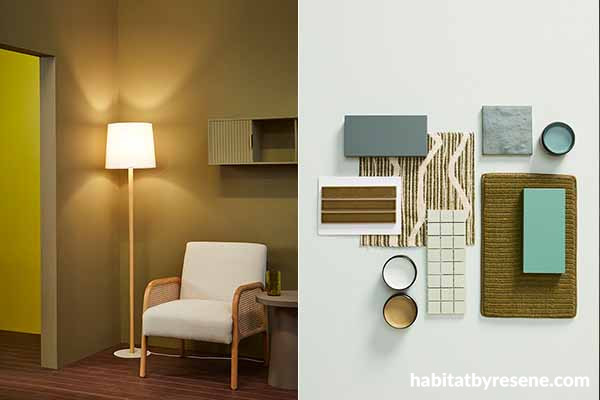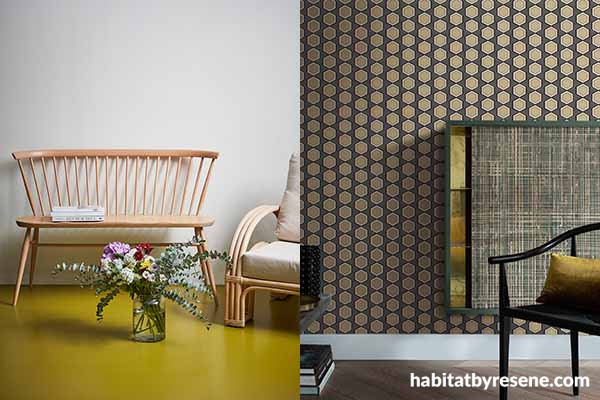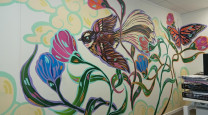
Neo-natural: popular earthy paint colours take on an unexpected twist
08 Jul 2024
For as long as humans have been building and decorating, hues borrowed from nature have been used ubiquitously. Before the advent of modern paints, earth-derived pigments that occurred naturally in our surroundings were understandably the only options available – and many of these hues were subtle and understated due to their high susceptibility to light or water. But despite exciting advancements in paint technology and the wide-spread availability of bolder and more saturated colours, muted earth tones continue to be an appealing option for many clients. Colours like brown, beige, taupe and green are not only versatile, they’re also highly comforting and calming. Unlike bolder trend-driven colours, earthy hues have a classic quality that adapt well to just about any style, from rustic and traditional to sleek and sophisticated contemporary looks.
Despite the timelessness of earth tones, they’re not immune to the ebb and flow of colour trends. As we look ahead in the colour forecast, there are some significant shifts that have begun to take place that are set to have a significant impact on which hues are viewed as vogue and which versions will begin to feel passé. Towards the end of this year and the beginning of next year, the most popular brown, beige, green and taupe paint colours will be taking on sharper undertones. When compared with the dusty, greyed-off variations that took us through the first half of the decade, the tones we’re about to see take over carry a distinct element of modernity thanks to their slightly acidic edge. If you have a project wrapping up in the coming months where your client is after an earthy palette, don’t overlook these can’t miss neo-natural colours from Resene to give your project a fresh and current look.

Left: Left wall painted in Resene Lemon Twist, right wall painted in Resene Mint Julep and floor stained in Resene Colorwood Bark. Dining table from Soren Liv, artwork by Scott Cai from Sanderson Contemporary, rug and pendant lamp from Ligne Roset, chair from Noho, stool from Tessuti, vase, candleholder and glassware from Faradays.
Right: Background painted in Resene Outlaw with Resene FX Paint Effects Medium mixed with Resene Kia Kaha applied on top and testpots in (from top to bottom) Resene Outlaw, Resene Kia Kaha and Resene Allspice.
What are neo-natural colours?
Earthy hues like brown, beige, green and taupe have long been associated with stability, comfort and neutrality. However, the modern ‘neo-natural’ reinterpretation of these colours infuses them with distinctly yellow and green undertones. These slightly soured and acidic hues carry a sense of dynamism and unpredictability, mirroring the complex relationship humans have with the natural world.

Left: Wall and floor painted in Resene Blank Canvas, window frames in Resene Sea Fog and lamp base in Resene Olive Green. Screen and mirror from Mocka, bench from Danske Mobler, bedside table from Good Form, rug and cushions from Baya, bedlinen from Foxtrot Home, bolster from Sunday Store.
Right: Accent wall (with doorway) and lamp base in Resene Rewilding, right wall and hallway wall in Resene Creme De La Creme, floor in Resene Tic Tac Toe with Resene FX Paint Effects Medium mixed with Resene Springtime applied over the top, arch vase in Resene Tic Tac Toe and floor vase in Resene Athena with Resene FX Paint Effects Medium mixed with Resene See The Light applied on top. Sideboard and chair from Danske Mobler, cushions and rug from Baya.
Pairing these updated earthy tones with complementary colours is essential to creating balanced and harmonious designs. Given that yellow or green undertones are inherent to these hues, other yellow and green hues are obvious complements – but they’re far from the only options.
Brassy browns infused with hints of yellow and green are a surprising twist on a classic hue that’s known for adding warmth, making spaces feel inviting yet modern. Pair yellow-green browns like Resene Bullwhip with inky blues or rich burgundies such as Resene Blue Charcoal or Resene Pandemonium to create a striking contrast that highlights the warmth of the brown. Soft creams and whites like Resene Meringue, Resene Half Scotch Mist or Resene Blanc can also be used to balance the vibrancy and maintain a grounded feel.
For many, beige and taupe have long been go-to neutrals that pair with just about anything. When mixed with yellow-green undertones, these hues take on a fresh, organic quality that feels distinctly different from the variations that dominated in the 80s and 90s without sacrificing flexibility. Complement a green beige like Resene Yuma with an earthy terracotta and a soft grey like Resene Tuscany and Resene Titania to enhance Resene Yuma’s appealing organic qualities. With a yellow-green taupe like Resene Akaroa, muted grey blues such as Resene Gull Grey and Resene Midwinter Mist impart an air of easy sophistication.
Green, a colour often associated with tranquility and renewal, becomes more assertive and contemporary when laced with lemon-lime undertones. With this sour edge comes vibrancy and a touch of the unexpected, invigorating spaces with a spritz of energy. Pair more intense varieties like Resene Funk and Resene Wasabi with a charcoal grey or navy blue like Resene Ebony Clay or Resene Ocean Waves for a modern, sophisticated look. Understated acidic greens like Resene Clay Creek and Resene Tic Tac Toe can benefit from the gentle contrast that soft pinks and peaches like Resene Soul Searcher and Resene Awaken can bring, creating a balanced and inviting space.
On lighter timbers, wood stains with green-edged undertones such as Resene Uluru, Resene Treehouse and Resene Bushtrack are excellent companions for many neo-natural colours like Resene Hindsight, Resene Outlaw, Resene Contour, Resene Off The Grid and Resene Rewilding. These stains also look lovely with warmer browns like Resene Cinnamon and contrast harmoniously with accents of deep spice brown, soft lavender or mint greens like Resene Brown Pod, Resene Sonique or Resene Kandinsky to create a bold, contemporary aesthetic.

Left: Timber background stained in Resene Colorwood Treehouse with A4 drawdown paint swatches in (from left to right) Resene Bleached Riverstone, Resene Charred Black, Resene Sandspit Brown, Resene Warmed Brown and Resene Waiouru and vase in Resene Brown Pod.
Right: Wall painted in Resene Cinnamon, floor finished in Resene Colorwood Breathe Easy and jug in Resene Egg Sour. Table and chairs from Mr. Bigglesworthy, vase from Flotsam & Jetsam, glassware from Father Rabbit, napkins from Claire Stapleton, plates and bowl from Smith & Caughey’s.
Where to use them
The key to successfully integrating these updated earth tones lies in understanding their impact and knowing where to apply them for maximum effect.
In residential homes, neo-natural colours can create environments that are both comforting and contemporary. Use browns with acidic undertones such as Resene Rewilding in lounges to foster a welcoming yet dramatic atmosphere. A beige with green undertones like Resene Hillary works well for bedrooms and bathrooms to promote relaxation with contemporary appeal. A green with an acidic yellow edge like Resene Grass Hopper is a perfect addition to kitchens and dining areas, where it can stimulate appetite and conversation. And a greige with a green heart like Resene Epitome is ideal for adding a touch of elegance and depth to a home office.
Retail spaces can benefit from the energy acidic green offers. A hue like Resene Go Ben balanced with algae green accents in Resene Green Meets Blue is also an effective colour combination for drawing attention while allowing neutral-coloured products to stand out in contrast. Clay browns with a yellow tint like Resene Piazza can create a cosy, approachable and appetising atmosphere in cafés and restaurants. Beiges with yellow or green undertones like Resene Sugar Loaf or Resene Bubble White are ideal wall colours for spas and wellness centres as these hues offer a soothing yet undeniably fresh vibe.
Public buildings such as museums, galleries and libraries can use these colours to evoke emotional responses and enhance the visitor experience. The dynamic nature of these hues can guide movement and can be used to create focal points within large spaces. For instance, a taupe with an acidic green undertone like Resene Beachcomber becomes a dramatic backdrop for artwork, while stronger acidic greens like Resene Karma can be used to highlight interactive exhibits and communal areas.

Left: Main walls, doorway and shelf painted in Resene Go Ben, adjacent room wall in Resene Funk, floor stained in Resene Colorwood Bark and side table in Resene Kabul. Chair from Mocka, lamp from Lighting Plus.
Right: Background painted in Resene Paris White and testpots in (clockwise from top left) Resene Green Meets Blue, Resene Go Ben and Resene Paris White. Materials in (clockwise from top left) Pressed panel from Fenix, square tile from The Tile People, carpet from Signature Floor Concepts, pressed panel from Fenix, small square tiles from The Tile People, fabric from Zinc Textile, finger tiles from Material Space.
Bring out their best
While the acidity of neo-natural earth tones can be intimidating to some, the key to using these colours effectively lies in balancing them with other elements in the space. Here are some top tips to keep in mind:
Add a variety of textures: Incorporate a variety of textures and materials to prevent brown from feeling flat or overwhelming. Think of combining matte and glossy finishes, using Resene SpaceCote Flat and Resene Enamacryl gloss, or mixing natural materials like wood, stone, and woven textiles.
Use effective lighting: Neo-natural paint colours can change significantly under different lighting conditions. Use warm lighting to enhance the cosy, inviting nature of these infused earthy shades, especially in residential settings. In public and commercial spaces, strategically-placed directional lighting can highlight the richness of stronger and deeper hues to make them look their best.
Make a statement:Stronger neo-natural tones like Resene Funk or Resene Grass Hopper make showstopping accent walls, statement floors or eye-catching ceilings when supported with more subdued options like Resene Rum Swizzle on adjacent walls.
Incorporate pattern and contrast: Integrate patterns that contain acidic green or yellow toned colours through textiles, rugs and wallpapers to add interest and dimension. Contrast deeper tones with paler or brighter colours to prevent the space from feeling too heavy.
For more upcoming colour trends, check out the Red Alert section in the latest issue of BlackWhite magazine.

Left: Wall painted in Resene Rum Swizzle and floor in Resene Grass Hopper. Bench from Good Form, chair from Danske Mobler.
Right: Wall in Resene Wallpaper Collection 297828. Complement it with timber flooring stained in Resene Colorwood English Walnut, furniture painted in Resene All Black and accents in brassy greens or browns like Resene Tarzan, Resene West Coast and Resene Teak for a similar look.
projects Amber Armitage, Melle Van Sambeek
images Bryce Carleton, Wendy Fenwick
Published: 08 Jul 2024






